Archive for March, 2013
Boots Motel gets Original Roof
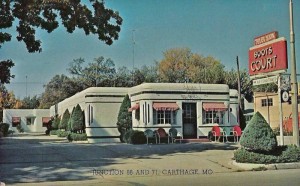
In Carthage Missouri the historical landmark Boots Motel is being returned back to its original look from back in the 1940’s. Sisters Priscilla Bledsaw and Debye Harvey bought the hotel 2 years with the intention of restoring it and getting the hotel in the National Register of Historic Places.
The property has been sold many times and was used as a rental property for years pushing it into severe disrepair.
Grants and Donations Helping Pay for the Project
The roofers are currently tearing off the 1970s gable roof and replacing it with the original roof-line which was a flat roof. A grant from the National Park Service’s Route 66 Corridor Preservation Program is paying for part of the roof the rest is coming from the owners and donations. The owners hope the roofing project will be completed within 3 weeks.
The new owners opened the office and five rooms in the 1946 annex building to route 66 travelers. The money from the rentals and souvenir sales will be used to restore the 8 original rooms in the main building.
Other work besides the new roof, will be restoring the original sign, and opening holes in the parapet walls to return the motel to the original design.
Harvey said “The room windows had sort of a scroll work design in neon around them. And the canvas awnings will be re-fabricated and reinstalled. We’re hoping we can use the same Carthage Company that did the originals.”
The hotel opened in 1939 and was originally Boots Court at 107 S. Garrison Avenue. The owners Arthur and llda Boots advertised “a radio in every room” and each room had a covered carport.
Florida Schools Get Hurricane Proof Roofs

Seven Seminole County Florida schools are receiving new roofs that will be able to withstand hurricane force winds. The re-roofing project will cost more than $2 million for the Seminole schools.
Traditional hurricane resistant roof materials depend on clips and special fasteners to hold the roof in place. These schools will be getting a different kind of system where the roof membrane will be sealed airtight and the recessed roofs will have special vents that will use the wind to cause a suction to keep the roof in place.
Using Wind to Create a Vacuum
Ralph Jewell, Vice President of Integrated Building Envelope Systems said the roofs were designed to use the wind to keep the roof down instead of fighting it. “Normally the wind is the nemesis, but we use that power to our advantage.” He said.
The design depends on the laws of physics and is for flat or low sloped roofs only. During a hurricane wind runs up the side of a building and across the top colliding and creating a swirling vortex above the roof, those swirling wind currents are capable of peeling a roof away.
The vents use the negative pressure caused by the swirling winds to pull the roof down with a vacuum action. The membrane is installed airtight on top of the building and lines up air vents along the perimeter. The wind vented design was patented 26 years ago and the company claims not a single roof has blown off.
Is Your Roof Ready For Spring?
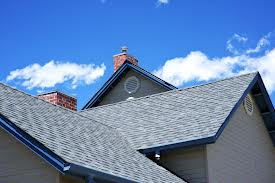 One crucial aspect of homeownership is to ensure that the roof is properly maintained. Failing to have the roof routinely inspected for damage or putting off simple roof repair tasks can jeopardize the integrity of the roof. Further, many insurance companies will deny a damage claim if they feel the roof was improperly maintained. Now that the weather is changing, it is important to ensure your roof is ready for springtime challenges.
One crucial aspect of homeownership is to ensure that the roof is properly maintained. Failing to have the roof routinely inspected for damage or putting off simple roof repair tasks can jeopardize the integrity of the roof. Further, many insurance companies will deny a damage claim if they feel the roof was improperly maintained. Now that the weather is changing, it is important to ensure your roof is ready for springtime challenges.
Changing Of The Seasons
Most people associate spring with warmer weather, sunshine and outdoor activities. However, in many parts of the country this also means a rainy season and threat of severe weather. Tornados, thunderstorms and prolonged periods of rain can all put an already damaged roof at risk for bigger problems. Follow these steps to ensure your roof is ready for the season:
- Take a closer look at your roof for any obvious signs of damage.
- Replace or repair missing, broken or bent roof materials.
- Have a roofer perform an inspection of the roof and provide you with a status report.
- You may even want to take pictures of your roof with a date and time stamp to document its undamaged condition.
- Keep a copy of the inspection report, or receipts of any repair work that is done to the home.
- File away these documents in case you need to file a damage claim in the coming months.
Roof Scammer Arrested

Baton Rouge police spokesman Lt. Don Kelly announced in a press release that 24 year old Brandon Ferguson of Baker was arrested at his home on Myrtle St., for scamming elderly victims out of money for faulty or non-existent roof repair. Ferguson is charged with three counts of theft of assets of an aged person and one count of felony theft.
Ferguson and other unidentified accomplices contacted the victims in the Red Oaks and Broadmoor areas over the past month. They told at least three victims that they needed a protective coating or had roof problems that needed repair. They quoted the victims, all in their 80’s, low prices and then intimidated them into paying more once the work was complete.
Useless “Protective Coating” Applied
According to the police, the protective coating they quoted was actually spraying paint on the roof.
Ferguson is also accused of taking jewelry from inside one of the homes.
Unfortunately the elderly can be easy targets for this type of scam. In most cases, the victims are unable to physically check their roof for repairs that are needed or supposedly completed.
The Baker Police Department are trying to determine if there are any more victims from these con men. Please contact the BRPD Financial Crimes Division at 225-389-3871 if you or someone you know may have been a victim in the Red Oaks and Broadmoor or surrounding areas.
Types of Roof Shingles

Asphalt strip shingles appearance and style added to the variety of shingle types makes them popular with homeowners and roofers. When first introduced, they were commonly called 3 tab shingles. The 1×3 foot strip had two short ½ inch cut outs at foot intervals giving it three shingle tabs.
The 3 tab shingle is still widely used today for roof materials, but heavier architectural shingles are becoming more popular. New manufacturing methods plus the double layering and use of larger heavier granules has raised the weight of the shingles.
Seal tabs for wind resistance feature incorporates into the shingle a row of adhesive at exact positions. The heat from the sun softens the glue and adheres to the shingle underneath.
Fiberglass Shingles
Fiberglass shingles have a different type of manufacturing process. The new shingles are made of fiberglass mat as a base for the asphalt instead of the organic felt base originally used. The fiberglass is considerably stronger than the felt and less bulky. Fiberglass shingles do not shrink and swell with humidity and moisture so they tend to outlast felt based shingles.
Shingle colors are determined by the tiny ceramic granules that are imbedded in the asphalt. You can also change the texture by double layering, irregular butt lines and two toning the shingle colors.
Asphalt shingles are chosen by their weight class as well as other features. The better quality shingles generally weigh more, and cost more. Asphalt shingles also carry certifications from Underwriters Laboratories stating their fire and wind resistance. A class “A” shingle will be more fire resistant than a class “C”.
Blue Instead of White for Reflective Roofs?
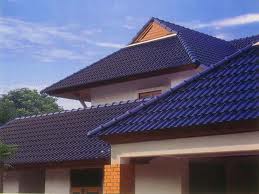
Research from Oregon State University describes how deep blue may be just as effective as white roofs in keeping the buildings cool. The researchers state that the sun’s rays don’t make objects warmer until they have been absorbed into the ground and get radiated as heat. So to keep a roof cool, you want to reflect the sun’s rays before it can be turned into heat.
Changing the chemical makeup of darker pigments can reflect as much of the rays as the common white roofs currently being used. The Oregon researchers mixed up and heated a bright blue pigment with manganese, yttrium and indium oxide that reflects the sun’s rays extremely well.
Cool Roof Color Choices Coming Soon
Other colors can be modified to be used in the cool roof tiles and the cost is nearly the same as asphalt or rubber roofing materials commonly used. The U.S. Recovery and Reinvestment Act funds are being spent for basic research into the new reflective pigments.
Cool roofs can reflect between 29 and 78 percent of the sun’s heat compared to 10 to 20 percent on conventional roofs. Construction of cool roofs is becoming standard procedure for new roofs, the Department of Energy calls for cool roofs to be incorporated whenever practical.
The Lawrence Berkeley National Laboratory’s Heat Island Group says an energy savings of $15 billion over 20 years, the average lifespan of a roof, for retrofitting 14,000 square miles of roofing.
This might be especially useful for apartment buildings that tower over flat white roofs. Tenants often complain about the bright white surface when looking out their windows.
Signs Of Roof Collapse
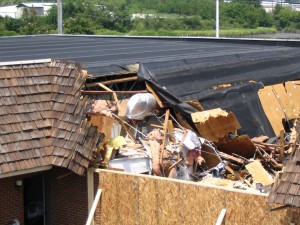 Some of the country is still experiencing heavy snowfall from winter storms. Even in climates where snow load isn’t a problem, there are issues that can threaten the integrity of a roof. Knowing the signs of a roof collapse can save lives and prevents thousands of dollars in additional roof repair costs.
Some of the country is still experiencing heavy snowfall from winter storms. Even in climates where snow load isn’t a problem, there are issues that can threaten the integrity of a roof. Knowing the signs of a roof collapse can save lives and prevents thousands of dollars in additional roof repair costs.
Staying Safe
Most cities have a builder’s code that enforces specific guidelines for roofing protocol. The code generally outlines rules for roof replacement, types of roof materials approved for use, limiting the number of material layers, and even outlines maximum weight load for a specific building. While not all roof problems result from the construction of the building, these safety codes are meant to protect people from the dangers associated with roof collapse.
Some of the warning signs that a roof may be dangerous are:
- Cracking, sagging, or water soaked materials
- Popping, cracking or groaning noises
- Cracks suddenly appearing in walls
- Bowing of walls or support columns
- Sudden roof leaks
- Door frames and window frames warping
- Sprinkler heads can start pushing down below the normal height of the ceiling
Avoid entering buildings with any of these signs, and call the local authorities to report the potential for danger.
Suit Filed in Green Roof Collapse

Owners of Aquascape in St. Charles are suing nine parties for $13 million in damages after the green roof partially collapsed two years ago. The section of the sloped roof that collapsed was 500 foot by 60 foot of the 256,000 square foot structure.
No one was injured when the 5 year old roof came down on February 13, 2011. The building is at 901 Aqualand Way in St. Charles Illinois.
$13 Million Payout
Aquascape’s insurance carrier paid out $13 million to cover reconstruction, damages and cost to move employees for a year while the roof repair is being completed.
The building at Aquascape’s headquarters has a gradual sloping roof from the north end to the south ends lowest point and continues on with an open parking area.
Aquascape makes water gardens, ecosystem ponds and backyard pond designs.
The roof is covered with prairie grass and other vegetation intended to absorb rainwater and provide natural insulation. The suit states that “the structure was not appropriately designed and constructed.”
The nine companies being sued are Artisan Design Build LLC, Senektekts, Tricon Construction, Tecza Environmental Group, Applied Ecological Services, Metallic Building Co., Olsson Roofing, Dewberry Architects and Area Erectors.
Area Erectors denies any wrongdoing and states they only followed the blueprints and did the work exactly how it was supposed to be done.
The suit for negligence and breach of contract was filed in Kane County and the court case is set to begin on May 16, 2013.
Roof Sheathing Condition
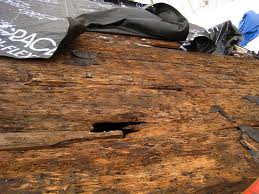
One of the major factors in re-roofing work is the condition of the existing roof sheathing underneath the roof covering. If through the years the sheathing boards have remained basically dry throughout all the areas of your roof you may be able to save money.
Moisture damaged boards will probably need to be replaced. Sometimes you can inspect the condition of your sheathing from the attic. Check any discolored spots for moisture and verify the wood’s firmness. If the boards are easy to penetrate with a screw driver you probably have moisture damage. Soft and soggy boards will need to be replaced.
Loose Nails Could Be Sign of Moisture Damage
The most likely area of moisture damage is in the lower sections of the roof, especially along the eaves. These areas are harder to inspect from the attic space and you will need to inspect the areas from outside the house. If the wood sheathing, fascia or trim have moisture damage and are rotting, sometimes it is easy to see the evidence in the form of loose nails and easy to lift or moving of the materials being probed with the screwdriver.
Rotting sheathing boards mean extensive roof repair work before the re-roofing. New materials won’t last long if placed on top of rotten boards. If different areas of the roof have the soft spots, it is recommended to remove the old roofing material completely and replace the damaged boards with new ones. If the damage appears to be limited to the lower sections of the roof you will not need to remove the old roofing, just the sections on the eaves can be replaced.
Sagging or waves on your roof surface could be the result of aging. In most cases new roof sheathing can me nailed right over the old wavy boards. Ask your roofer or roofing contractor what the condition of your sheathing boards are during the initial inspection or consultation so you won’t be surprised by the additional costs as the job progresses.






